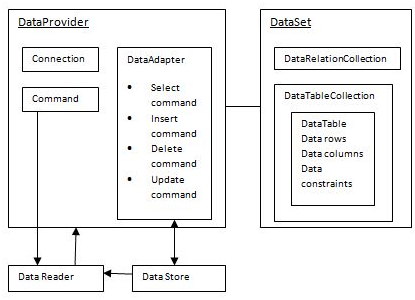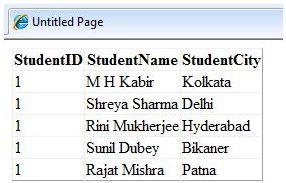ADO.NET:
ADO.Net gives a bridge between the front end controls and the back end database. The ADO.Net objects encapsulate all the data access operations and the controls communicate with these objects to display data, thus hiding the details of group of data.
The subsequent figure illustrates the ADO.Net objects at a glance:

The DataSet Class:
The data set shows a subset of the database. It does not have a continuous connection to the database. To update the database a reconnection is needed. The DataSet has DataTable objects and DataRelation objects. The DataRelation objects show the relationship between two tables.
subsequent table shows some important properties of the DataSet class:
|
Properties
|
Description
|
|
CaseSensitive
|
Specify whether string comparisons within the data tables are case-sensitive.
|
|
Container
|
Gets the container for the component.
|
|
DataSetName
|
Gets or sets the name of the present data set.
|
|
DefaultViewManager
|
Gives a view of data in the data set.
|
|
DesignMode
|
Denotes whether the component is presently in design mode.
|
|
EnforceConstraints
|
Denotes whether constraint rules are followed when attempting any update operation.
|
|
Events
|
Gets the list of event handlers that are attached to that component.
|
|
ExtendedProperties
|
Gets the collection of customized user information related with the DataSet.
|
|
HasErrors
|
Denotes if there are any errors.
|
|
IsInitialized
|
Denotes whether the DataSet is initialized.
|
|
Locale
|
Gets or sets the locale information used to check strings within the table.
|
|
Namespace
|
Sets or gets the namespace of the DataSet.
|
|
Prefix
|
Sets or gets an XML prefix that aliases the namespace of the DataSet.
|
|
Relations
|
Gives the collection of DataRelation objects.
|
|
Tables
|
Gives the collection of DataTable objects.
|
subsequent table illustrates some important methods of the DataSet class:
|
Methods
|
Description
|
|
AcceptChanges
|
Accepts all modification made since the DataSet was loaded or this method was called.
|
|
BeginInit
|
Begins the initialization of the DataSet. The initialization happens at run time.
|
|
Clear
|
Clears data.
|
|
Clone
|
Copies the structure of the DataSet, adding all DataTable schemas, relations, and constraints. Does not copy any data.
|
|
Copy
|
Copies both the structure and data.
|
|
CreateDataReader()
|
Gives a DataTableReader with one result set per DataTable, in the same sequence as the tables seems in the Tables collection.
|
|
CreateDataReader(DataTable[])
|
Gives a DataTableReader with one result set per DataTable.
|
|
EndInit
|
Ends the initialization of the data set.
|
|
Equals(Object)
|
Calculates whether the specified Object is equal to the present Object.
|
|
Finalize
|
Free resources and operate other cleanups.
|
|
GetChanges
|
Gives a copy of the DataSet with all modification made since it was loaded or the AcceptChanges method was called.
|
|
GetChanges(DataRowState)
|
Gets a copy of DataSet with all modification made since it was loaded or the AcceptChanges method was known, filtered by DataRowState.
|
|
GetDataSetSchema
|
Gets a copy of XmlSchemaSet for the DataSet.
|
|
GetObjectData
|
Populates a serialization data object with the data required to serialize the DataSet.
|
|
GetType
|
Gets the kind of the present instance.
|
|
GetXML
|
Gives the XML representation of the data.
|
|
GetXMLSchema
|
Gives the XSD scheme for the XML representation of the data.
|
|
HasChanges()
|
Gets a value representing whether the DataSet has changes, including new, deleted, or modified rows.
|
|
HasChanges(DataRowState)
|
Gets a value representing whether the DataSet has changes, including new, deleted, or modified rows, filtered by DataRowState.
|
|
IsBinarySerialized
|
Inspects the format of the serialized demonstration of the DataSet.
|
|
Load(IDataReader, LoadOption, DataTable[])
|
Fills a DataSet with values from a data source with the supplied IDataReader, using an array of DataTable instances to provide the schema and namespace information.
|
|
Load(IDataReader, LoadOption, String[])
|
Fills a DataSet with values from a data source using the supplied IDataReader, using an array of strings to provide the names for the tables within the DataSet.
|
|
Merge()
|
Merges the data with data from one more DataSet. This technique has different overloaded forms.
|
|
ReadXML()
|
Reads an XML schema and data into the DataSet. This technique has different overloaded forms.
|
|
ReadXMLSchema(0
|
Reads an XML schema into the DataSet. This function has different overloaded forms.
|
|
RejectChanges
|
Rolls back all modification made since the last call to AcceptChanges.
|
|
WriteXML()
|
Writes an XML schema and data from the DataSet. This function has different overloaded forms.
|
|
WriteXMLSchema()
|
Writes the structure of the DataSet as an XML schema. This function has different overloaded forms.
|
The DataTable Class:
The DataTable class shows the tables in the database. It has the following important properties; most of these properties are read only types except the PrimaryKey property:
|
Properties
|
Description
|
|
ChildRelations
|
Gives the collection of child relationship.
|
|
Columns
|
Gives the Columns collection.
|
|
Constraints
|
Gives the Constraints collection.
|
|
DataSet
|
Gives the parent DataSet.
|
|
DefaultView
|
Gives a view of the table .
|
|
ParentRelations
|
Gives the ParentRelations collection.
|
|
PrimaryKey
|
Gets or sets an array of columns as the primary key for the table.
|
|
Rows
|
Gives the Rows collection.
|
Following table shows some important methods of the DataTable class:
|
Methods
|
Description
|
|
AcceptChanges
|
Commits all changes since the last AcceptChanges.
|
|
Clear
|
Clears all data from the table.
|
|
GetChanges
|
Gives a copy of the DataTable with all changes made since the AcceptChanges method was called.
|
|
GetErrors
|
Gives an array of rows with errors.
|
|
ImportRows
|
Copies a new row into the table.
|
|
LoadDataRow
|
Searches and updates a specific row, or creates a new one, if not found any.
|
|
Merge
|
Merges the table with another DataTable.
|
|
NewRow
|
Prepares a new DataRow.
|
|
RejectChanges
|
Rolls back all modification made since the last call to AcceptChanges.
|
|
Reset
|
Resets the table to its real state.
|
|
Select
|
Provides an array of DataRow objects.
|
The DataRow Class:
The DataRow object signifies a row in a table. It has the subsequent important properties:
|
Properties
|
Description
|
|
HasErrors
|
Shows if there are any errors .
|
|
Items
|
Sets or gets the data stored in a specific column .
|
|
ItemArrays
|
Sets or gets all the values for the row.
|
|
Table
|
Provides the parent table .
|
Following table shows some important methods of the DataRow class:
|
Methods
|
Description
|
|
AcceptChanges
|
Accepts all modification made since this method was called.
|
|
BeginEdit
|
Takes edit operation.
|
|
CancelEdit
|
Cancels edit operation.
|
|
Delete
|
Eliminates the DataRow .
|
|
EndEdit
|
Ends the edit operation.
|
|
GetChildRows
|
Takes the child rows of this row.
|
|
GetParentRow
|
Gets the parent row.
|
|
GetParentRows
|
Gets parent rows of DataRow object.
|
|
RejectChanges
|
Rolls back all modifications made since the last call to AcceptChanges.
|
The DataAdapter Object:
The DataAdapter object behaves as a mediator between the DataSet object and the database. This helps the data set to have data from more than one database or other data source.
The DataReader Object:
The DataReader object is an another way to the DataSet and DataAdapter combination. This object gives a connection oriented access to the data records in the database. These objects are suitable for read-only accesses, such as increasing a list and then breaking the connection.
DbCommand and DbConnection Objects:
The DbConnection object shows a connection to the data source. The connection may be shared among different command elements.
The DbCommand object shows the command or a stored method sent to the database from getting or manipulating data.
Example:
So far, we have used tables and databases already having in our computer. In this example, we will prepare a table, add column, rows and data into it and show the table using a GridView object.
The source file:
|
<%@ Page Language="C#"
AutoEventWireup="true"
CodeBehind="Default.aspx.cs"
Inherits="createdatabase._Default" %>
<!DOCTYPE html PUBLIC "-//W3C//DTD XHTML 1.0 Transitional//EN"
"https://www.w3.org/TR/xhtml1/DTD/xhtml1-transitional.dtd">
<html xmlns="https://www.w3.org/1999/xhtml" >
<head runat="server">
<title>Untitled Page</title>
</head>
<body>
<form id="form1" runat="server">
<div>
<asp:GridView ID="GridView1" runat="server">
</asp:GridView>
</div>
</form>
</body>
</html>
|
The code behind file:
|
namespace createdatabase
{
public partial class _Default : System.Web.UI.Page
{
protected void Page_Load(object sender, EventArgs e)
{
if (!IsPostBack)
{
DataSet ds = CreateDataSet();
GridView1.DataSource = ds.Tables["Student"];
GridView1.DataBind();
}
}
private DataSet CreateDataSet()
{
//creating a DataSet object for tables
DataSet dataset = new DataSet();
// creating the student table
DataTable Students = CreateStudentTable();
dataset.Tables.Add(Students);
return dataset;
}
private DataTable CreateStudentTable()
{
DataTable Students = new DataTable("Student");
// adding columns
AddNewColumn(Students, "System.Int32", "StudentID");
AddNewColumn(Students, "System.String", "StudentName");
AddNewColumn(Students, "System.String", "StudentCity");
// adding rows
AddNewRow(Students, 1, "M H Kabir", "Kolkata");
AddNewRow(Students, 1, "Shreya Sharma", "Delhi");
AddNewRow(Students, 1, "Rini Mukherjee", "Hyderabad");
AddNewRow(Students, 1, "Sunil Dubey", "Bikaner");
AddNewRow(Students, 1, "Rajat Mishra", "Patna");
return Students;
}
private void AddNewColumn(DataTable table,
string columnType,
string columnName)
{
DataColumn column = table.Columns.Add(columnName,
Type.GetType(columnType));
}
//adding data into the table
private void AddNewRow(DataTable table, int id,
string name, string city)
{
|
When you run the program observe the following:
- The application first makes a data set and binds it with the grid view control needing the DataBind() function of the GridView control.
- The Createdataset() function is a user described function, which prepares a new DataSet object and then calls anther user defined function CreateStudentTable() to build the table and add it to the Tables collection of the data set.
- The CreateStudentTable() prepare calls the user described methods AddNewColumn() and AddNewRow() to prepare the columns and rows for the table as well as to include data to the rows.
When the page is run, it provides the rows of the table so created:

Email based ASP.Net assignment help - homework help at Expertsmind
Are you searching ASP.Net expert for help with ADO.NET questions? ADO.NET topic is not easier to learn without external help? We at www.expertsmind.com offer finest service of ASP.Net assignment help and ASP.Net homework help. Live tutors are available for 24x7 hours helping students in their ADO.NET related problems. Computer science programming assignments help making life easy for students. We provide step by step ADO.NET question's answers with 100% plagiarism free content. We prepare quality content and notes for ADO.NET topic under ASP.Net theory and study material. These are avail for subscribed users and they can get advantages anytime.
Why Expertsmind for assignment help
- Higher degree holder and experienced experts network
- Punctuality and responsibility of work
- Quality solution with 100% plagiarism free answers
- Time on Delivery
- Privacy of information and details
- Excellence in solving ASP.Net queries in excels and word format.
- Best tutoring assistance 24x7 hours